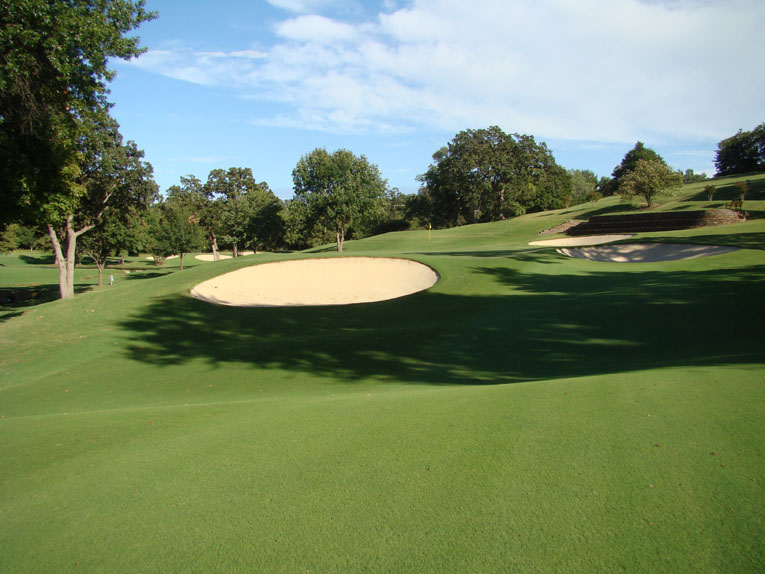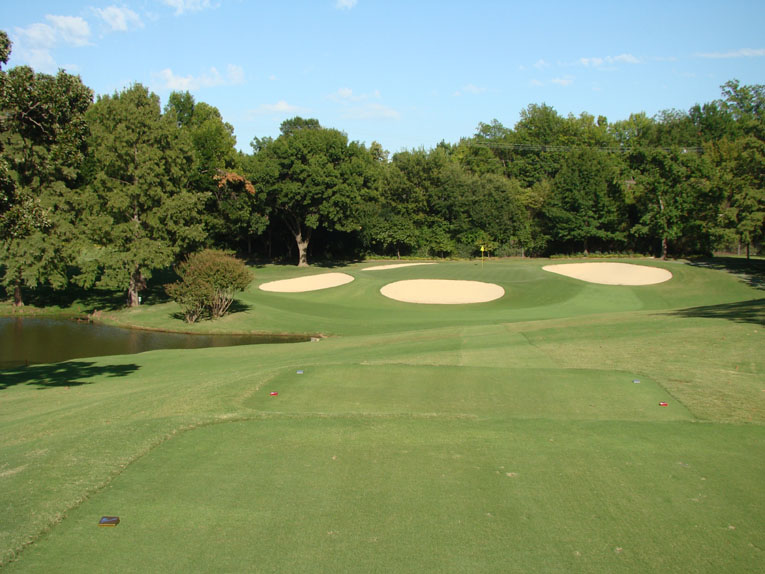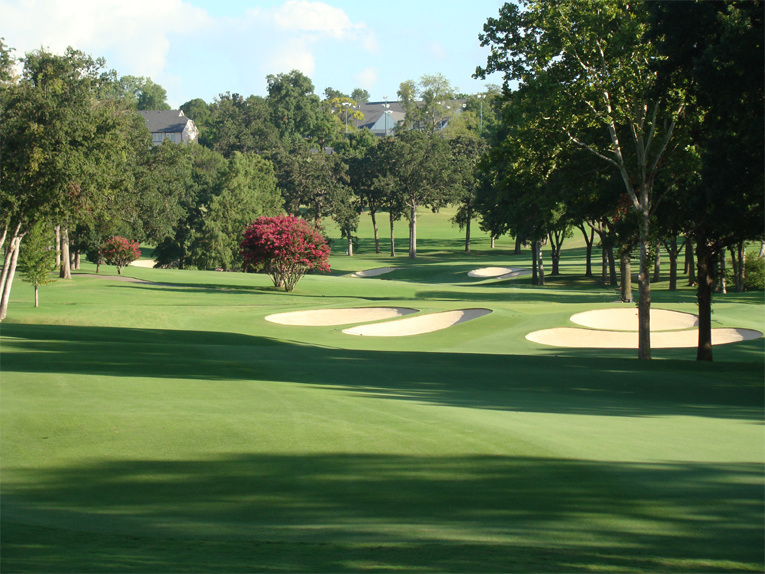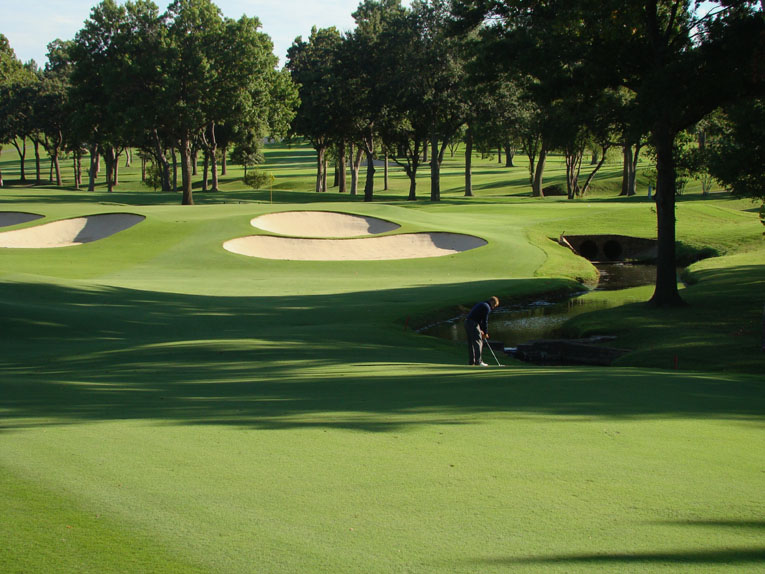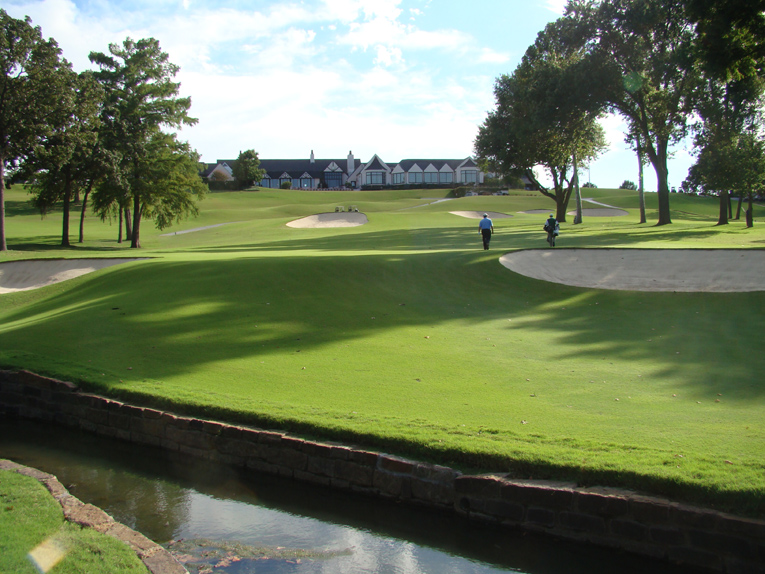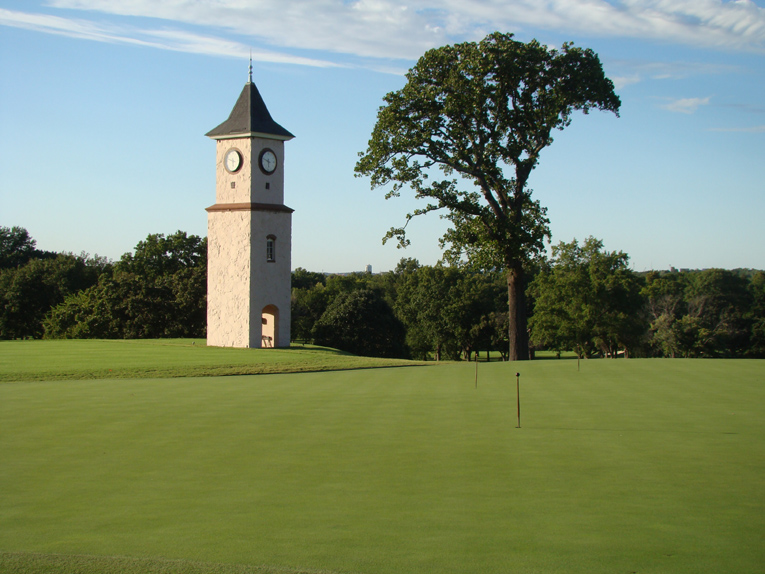Southern Hills Country Club, OK, USA

Topography, creeks and Perry Maxwell come together in spectacular fashion at Southern Hills. The course has evolved into one of the prettiest parkland examinations in world golf.
Even in this part of the world where people think big, dreams can be exceeded. Three US Opens, four PGA Championships, and a slew of other important professional and amateur events later, the founders’ vision of Southern Hills has surely been surpassed. More importantly the club has never been more vibrant and the course better presented than it is today.
The story begins in 1934. Despite the lasting effects of the Great Depression, weak oil prices and the Dust Bowl, Bill Warren and Cecil Canary banded together with the hopes of bringing great golf events to Tulsa. Waite Phillips contributed the land that featured a high hill which gave way to a rolling terrain laced with meandering creeks. Importantly, it was blessed with a greater sand component than typical Oklahoma red clay because of periodic flooding of the Arkansas River over the millennia. Though the founders’ investment was surely questioned during those unsettled times, there was no question as to whom they would hire to build the desired course: Perry Maxwell from Ardmore, Oklahoma, 200 miles down the road.
Maxwell had already built several of his finest courses including Dornick Hills and Twin Hills. His partnership with Dr. Alister MacKenzie had yielded Crystal Downs and Oklahoma G&CC as well. In all cases, his work was characterized by the manner in which the holes rested peacefully upon the ground and how the challenge stiffened around the green. The term ‘Maxwell rolls’ was coined in appreciation of his unique ability to build interior contours and slopes on intermediate size greens. The founders of Southern Hills made it clear to Maxwell of their desire to have a course to test the best and gave Maxwell his pick from 330 acres in the hills of south Tulsa.
Certainly, an upside of inland golf is that it can be situated near where people live and work, making golf an integral part of their lives. The downside is that such non-sand based courses generally occupy land that lacks the intricate movement of seaside courses where the wind has shaped landforms of two to seven feet (i.e. human-scale). Such seaside courses are endlessly fascinating because they play so differently from day to day based on the wind and the stances that the random land movement dolls out. One day, a ball might be six inches above your stance and the next it might be six inches below. The good golfer appreciates what a difference this can make in executing the proper shot. The better the golfer, the more he accepts the challenge as a way to showcase his shot-making repertoire.
Alas, inland courses generally don’t hold such mysteries because their slopes are broader. Southern Hills is that rare – and wonderful – exception where the land heaves and falls in a delightfully random manner. Maxwell brilliantly employed these landforms where they matter most: in the hitting areas off the tee. A quick tick through the holes highlights the variety of stances that the course metes out: the second fairway’s right to left cant, the fourth’s pronounced gully, the seventh’s reverse camber (i.e. the hole elbows to the left though the land tilts left to right), the ninth’s uphill slopes, the tenth’s side slopes, the twelfth’s right to left tilt, and finally the jumbled landforms in the hitting areas at the thirteenth, sixteenth, seventeenth and eighteenth holes. Members relish games in their fourth decade of playing the course as much as they did in the first as the challenges shift from one round to the next.
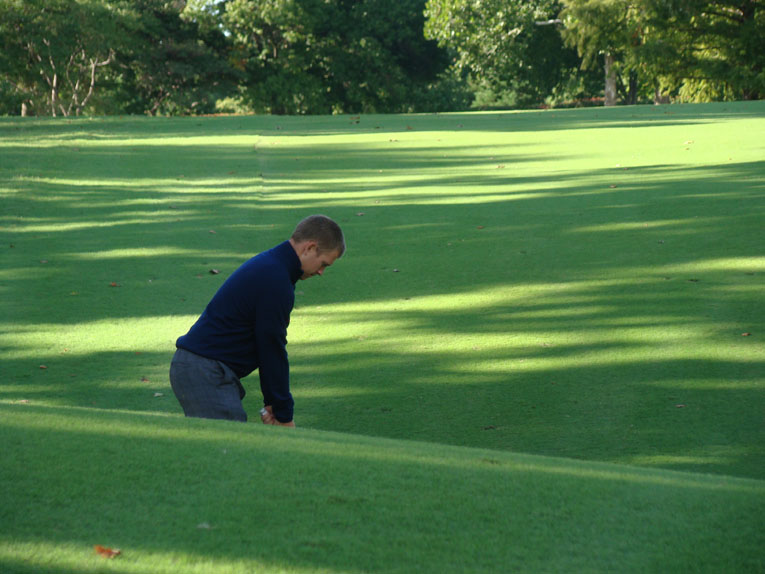
Maxwell perfectly captured the site’s natural folds and ridges in the second shot area of numerous holes. The golfer above is in the ‘go-zone’ at the reachable thirteenth but his stance is problematic.
Chris Clouser’s information packed The Midwest Associate, a cornerstone book on Maxwell, highlights how he gained such an intense appreciation for golf course design and the optimal use of land. Initially, Maxwell built a four hole course on his family plot that later became Dornick Hills. His tour of National Golf Links of America with Charles Blair Macdonald in 1914 set the stage for his own voyage to the United Kingdom in 1919 to see some of the great links courses including The Old Course at St. Andrews, Prestwick and Hoylake. In between NGLA and the United Kingdom, he toured the best courses in the southeast of the United States, headlined by Donald Ross’s work. Everything that Maxwell learned from those visits was poured into Southern Hills including the means to route eighteen holes while disturbing the land in a minimal manner, an efficiency of construction technique, irrigation and even the bent grassing scheme for the greens. Though money was tight for construction, Maxwell delivered a stellar design whose bones have required little tinkering since.
In a recent email exchange with the author, Clouser notes that: Maxwell did not use large machinery or try to create a manufactured look like some of his contemporaries. His designs were about using the land as it was presented and routing a course based on those features as you see at Southern Hills, Prairie Dunes and Crystal Downs, or even little know courses like Cushing or Bristow. That is why he used the hill at Southern Hills in so many of the holes as well as its meandering creeks. He incorporated dynamic natural features in as many ways as possible in his work. His methods were manual in nature with horse-pulled fresnos and plows doing the heavy work. There wasn’t time or money for most of his courses to do anything that wasn’t based on the natural flow of the ground. Hence, his courses enjoy a timeless appeal.
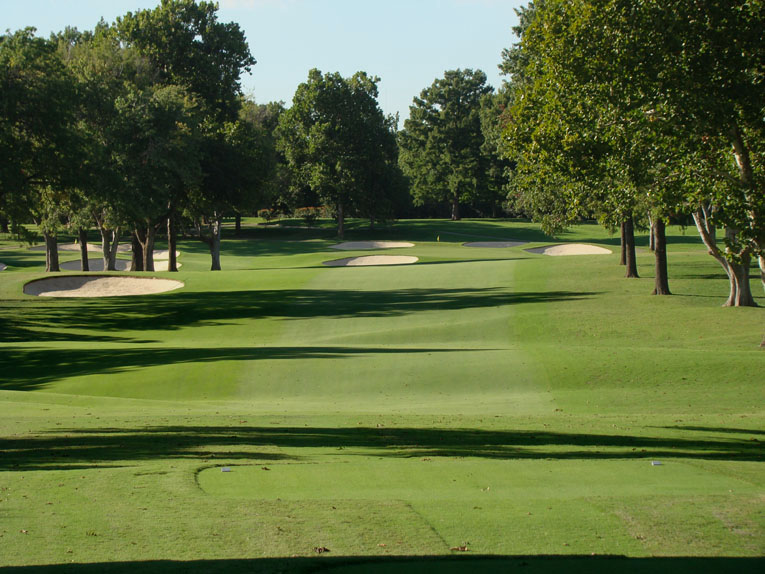
Once over-treed, Southern Hills has embarked on an intelligent tree plan over the past decade that involved the removal of non-indigenous trees as well as limbing-up others. Long views are now afforded across the gorgeous rolls of the property, highlighting Maxwell’s soft touch upon the land.
With the birth of Sand Hills in Nebraska in the mid 1990s came a renewed appreciation for golf on the prairie. While much of Oklahoma lies in the Great Plains and some people wish to transpose the blown out bunkers of Sand Hills or Ballyneal onto the Tulsa landscape it doesn’t work because Tulsa is in the wooded transitional area of the state between the Great Plains and the Ozarks. Specimen oaks, maples, sycamores and elms now give Southern Hills a regal quality and the course, to the author, is most meaningfully compared to Augusta National. From 1935 to 1938, Maxwell worked on his two most famous original designs (Southern Hills and Prairie Dunes) and two seminal designs (Augusta National and National Golf Links of America). The similarities with Augusta run deep. Both courses feature a dominant landform occupied by the clubhouse. The nines start and return underneath the gaze of the respective clubhouses. The holes at both naturally wander up, down and around hillocks and vales punctuated by streams, ponds and graceful bunkers.

The first, fourth as pictured above, fifth, ninth, tenth, and eighteenth holes all play toward, away or beside the hill upon which the clubhouse is located.
Creeks and ponds dominate play away from the hill. Both courses were once much more open and had ragged-edged bunkers through the 1960s. Each passing decade has seen the two courses become more tree-lined and manicured. Today the bunker edges are sharp and clean-edged. Both courses embrace and cultivate their mature parkland settings and in doing so, set a standard of beauty against which few other parkland courses can compete. Though the aesthetics of both courses have changed over the last fifty years, the fundamental design principles of MacKenzie and Maxwell still define the respective courses. The pair challenges the best without resorting to tricks or gimmickry and both are streamlined in appearance. No detail is too small at either place. For instance, Southern Hills takes great pride in its sightlines to the point that trash receptacles are submerged underground near tees.

Like Augusta National, Southern Hills features creeks that simultaneously lend strategy, danger and serenity to the proceedings.
Every golfer is intimately familiar with Augusta National’s splendor because of a certain April broadcast that comes at the height of its spring beauty. Unfortunately, Southern Hills suffers the opposite fate. It’s summer when big events roll into town and television viewers see golfers toiling in high heat and humidity. Such images create grossly false impressions of just how enjoyable rounds typically are. The pictures throughout this profile were taken at the start of autumn and hopefully provide balance. Without doubt, Southern Hills is one of the prettiest places to enjoy a game in world golf.
Holes to Note
(Please note: yardages are provided for the back markers of 7,200 yards as well as from the eminently enjoyable 6,600 yard white tees.)
First hole, 465/455 yards; There is no more stylish start to a round than high on a tee near a clubhouse and launching a ball well into the distance in front of onlookers. That very opportunity exists here in spades. In fact, the new back tee from Keith Foster is within ten paces of the golf professional shop! The more difficult of the two shots on the opening hole is controlling one’s approach shot into a green which falls gradually toward the back.
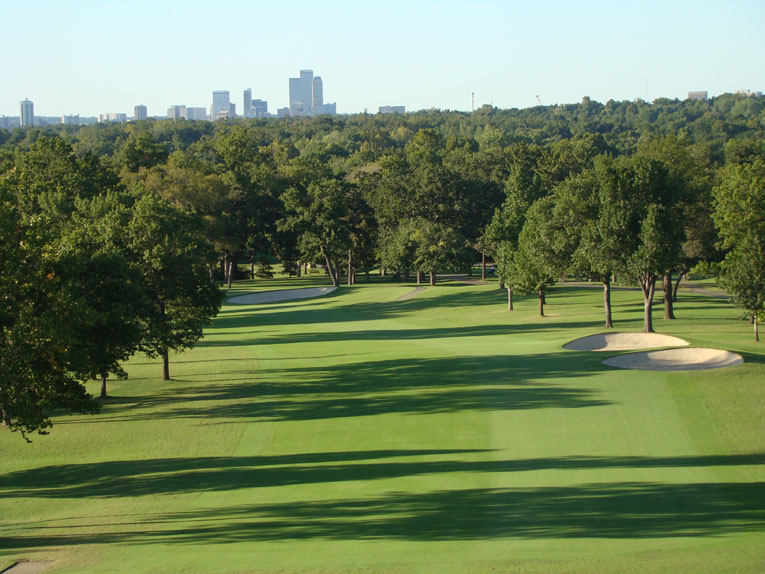
Keith Foster is the architect of record at Southern Hills. Since 1999, he has fine-tuned the course to perfection. Case in point is how he edged the first hole bunkers into the fairway. Previously they were tucked away on the side and didn’t influence the line off the tee. Downtown Tulsa’s skyline is six miles away.
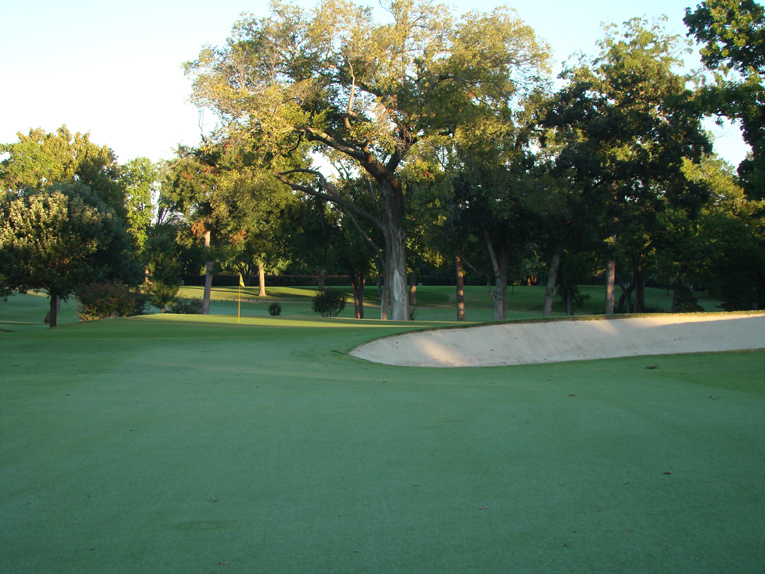
An appreciation of Maxwell’s building technique is found at the first green pad. Though it appears as a mere extension of the fairway, Maxwell actually moved significant fill to build it up. The back of the green pad is a full six feet above the natural grade and yet it looks like nothing was disturbed. No architect has ever been better at moving dirt and making it look like he hadn’t than Maxwell.
Second hole, 485/415 yards; Everything possible is thrown at the golfer to where many consider this the best hole on the course. Yet, it is encountered so early in the round that it rarely receives the notoriety it deserves. The creek diagonally slashes across the line of play off the tee before tracking up the left side of the fairway, where the flattest lies are afforded. The largest green on the course at 5,840 square feet peaks in its middle before dropping away to the back right where, alas, the same creek flows.
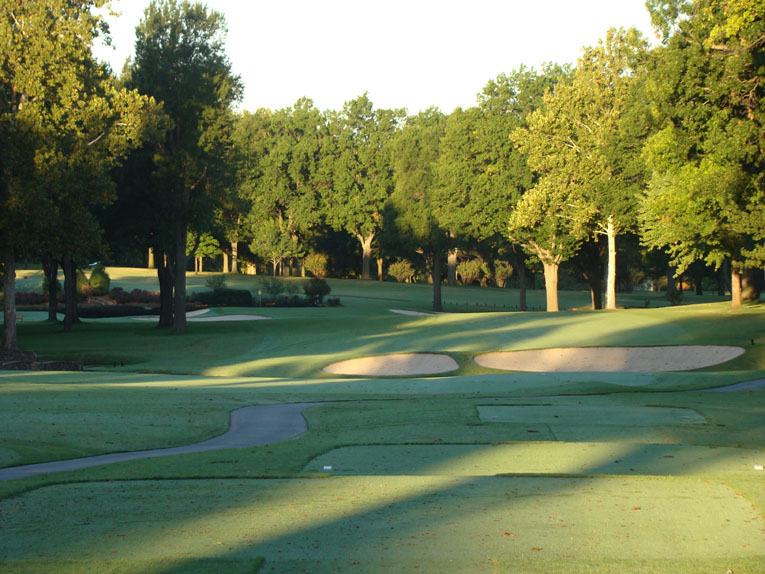
With the stream left, golfers like to stay to the right. However, the more level stances are offered closer to the stream.
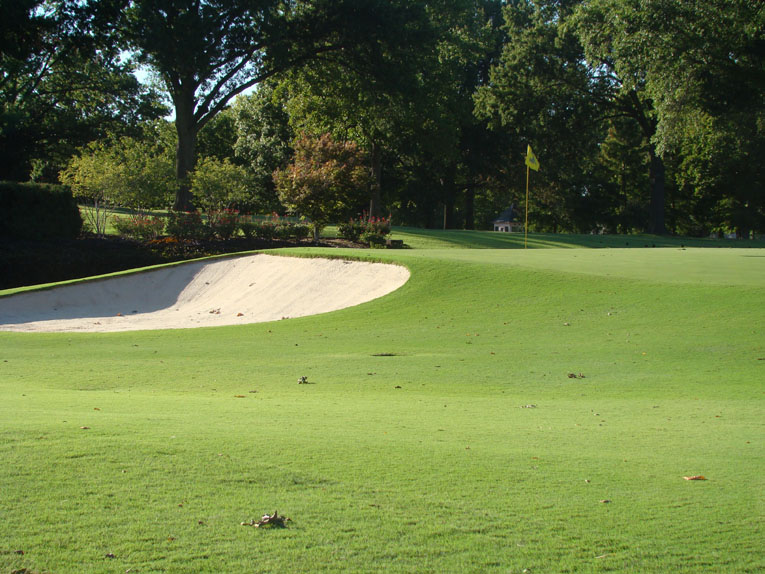
This same photograph taken in 2000 would have shown rough and a large oak tree square in the center of the picture. Short grass now represents a vital component to the overall challenge at Southern Hills. Recovery from tight turf to Maxwell’s greens taxes the golfer’s touch and nerves.
Third hole, 450/380 yards; Good drivers relish the advantages they enjoy at Southern Hills and the course has always been considered first and foremost a placement course. Ben Hogan likened its Bermuda rough to ‘steel wool’ during the 1958 US Open. For daily play, such rough isn’t kept tall because balls readily sink to the bottom, assuring a penalty for straying from the fairway. Hence, little time is wasted looking for golf balls at Southern Hills and rounds enjoy a nice flow/rhythm. For missed tee balls, there is an art form to recovery; it isn’t a simple matter of merely slapping the ball down the fairway. Hazards directly in the line of play, be it the creek that crosses eighty yards from this green or the knob that is forty yards shy of the tenth green, create the need for prudence. A pitch to save par on such holes might well have to come from ~100 yards away. Reaching for the driver is not a foregone conclusion at Southern Hills; three woods, hybrids and long irons that find the fairway will put the golfer in good stead against an ill-prepared golfer with a ‘bomb and gouge’ mindset.
Sixth hole, 200/170 yards; Maxwell incorporated the creek between the tee and green five times: here, the second, third, twelfth, and eighteenth. This hole occupies the lowest part of the property and the swollen creek is acutely felt on the tee. Nonetheless, it only menaces pulled shots and there is lots of short grass short and right of the green. To the author, the short grass presents an appealing ‘miss’ area. When the area was maintained as rough, the tee ball had a one-dimensional ‘aim for the green or else’ mentality. The implementation of short grass admirably creates more options and therefore more indecision.
Seventh hole, 385/370 yards; A sub-400 yard hole that can’t routinely be beaten becomes misunderstood and infuriating. As such, an architect should as a matter of good practice build at least one such perplexer per course! Southern Hills has several, which nicely balance the prodigiously difficult second, twelfth and eighteenth. Finding the left side of the fairway here is important yet the left to right cant of the ground is of no help. Like the challenges found at the Olympic Club in San Francisco, the golfer ideally shapes a draw to hold the left side of the fairway. Tee balls missed straight through the fairway find a difficult Bermuda lie and a poor angle with potential tree trouble. Though it fits in with the rest of the course, this green complex is the only non-original Maxwell on the course (Maxwell’s green was shorter and well to the left). Loy Martin moved it here in the early 1960s after hail damage forced Southern Hills to rebuild all eighteen greens after the 1958 US Open. Interestingly enough, the USGA had just released a paper on USGA spec greens and it is believed that Southern Hills was the first club in the country to implement them. Foster has helped insure that Martin’s handiwork blends in well with what is emphatically a Maxwell course.
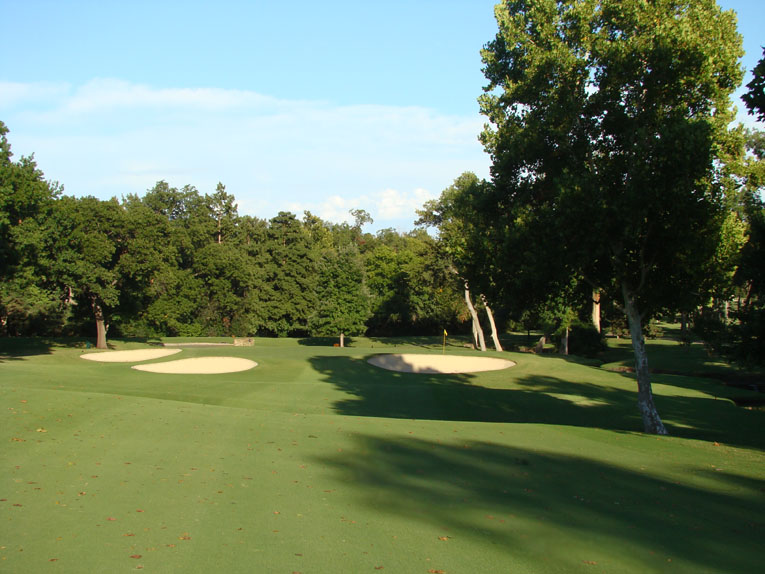
The left to right cant of the fairway coupled with a mature sycamore 90 yards from the green play off each other to complicate matters for the golfer.
Eighth hole, 245/200 yards; This long one shotter produces more than its share of optical illusions. The green itself is draped over a ridge with the front 2/3 facing the golfer and the back 1/3 falling away. Shots hit into the upslope really brake while shots beyond the ridge race away. From the tee, the eighth doesn’t seem to rise that much but the view back from the green properly conveys its ascent. Hubert Green treated this hole like Billy Casper did the third at Winged Foot: he laid up short of the putting surface all four days of the 1977 US Open, relying on his short game/short grass prowess to save par.
Ninth hole, 375/360 yards; Knowing when to move a bunker built by a master architect from the Golden Age requires finesse. Few restorers are more artful than Foster. On this hole Maxwell’s lone fairway bunker had been rendered meaningless by advancements in technology. Since it wasn’t cut into a landform, Foster was free to push it back. He also edged it more into the fairway. Without doubt, Maxwell would have done the same if he was alive today. Thus, job well done by Foster.

Thanks to Foster’s work, this fairway bunker is once again ideally placed (i.e. it is right where the golfer wishes it wasn’t!). Fairways feed directly into the bunkers throughout Southern Hills at the wise suggestion of PGA Championship Chief Tournament Officer Kerry Haigh.

Tiger Woods played the ninth 4 over par in 2001; his high spinning wedges continually found trouble on the steeply pitched green. He finished well back in the field. By 2007, he had learned to control his wedge shots and played the hole in even par en route to winning the PGA Championship.
Tenth hole, 365/365 yards; Maxwell built approximately 50 courses during his career. He might have done more if not for world events like the Great Depression and World War II but not too many more because he was a hands-on architect. The amount of time he spent on sites manifests itself in many beneficiary ways and one of the most important being routings of the highest standard. Slotting the tumbling tenth fairway around the bend of the hillside and over a distinctive knob is but one example of Maxwell’s aptitude for presenting a variety of challenges in an unforced manner.
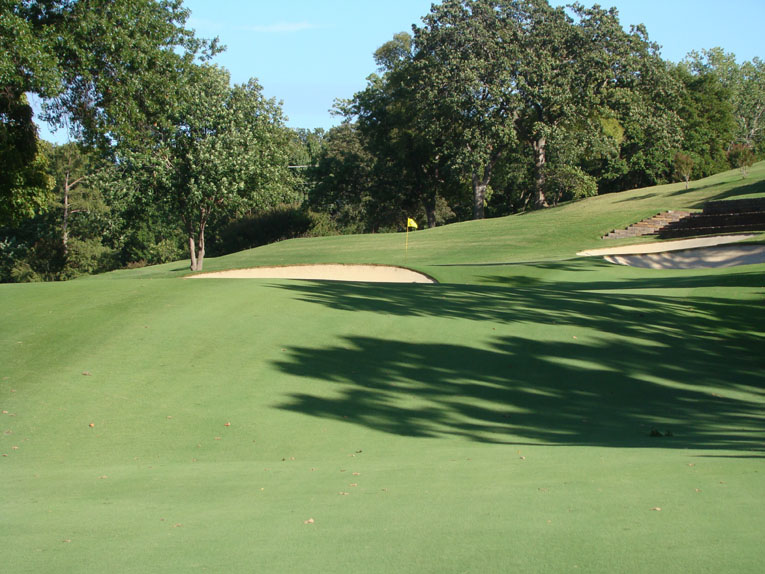
Depth perception is difficult here where a big knoll forty yards short of the green obscures much of the front bunker and effectively creates a forty yard ‘dead’ area to the eye. Mystery is an important element that all great courses possess.
Eleventh hole, 175/155 yards; Tucked in the corner of the property, this little beauty requires an exacting approach below the day’s hole location. The 3,332 square foot green is the smallest target on the course and its back right to front left tilt is always a consideration. It is amazing how quickly a golfer can go from thinking about birdie to praying for par with the tightly mown green banks adept at whisking balls into awkward recovery positions.
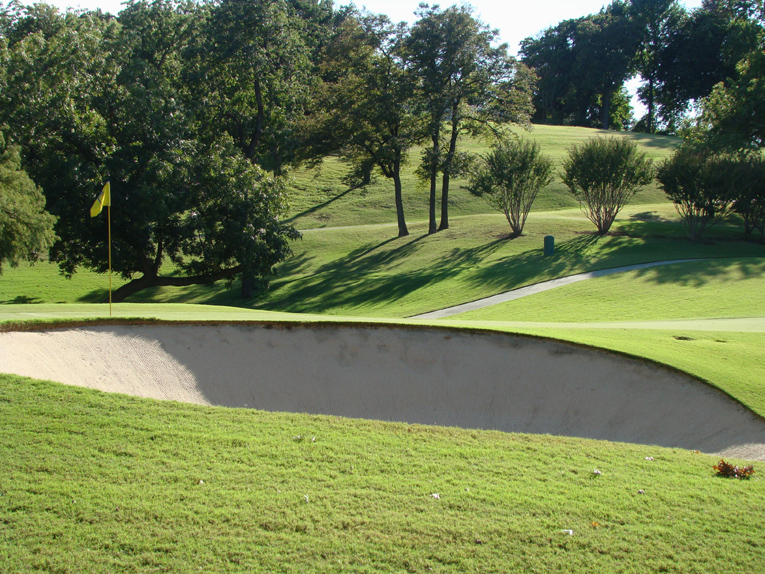
Both the bunker depth and their vertical faces are best appreciated from a distance! The bunkers around the course are in general deeper today than in Maxwell’s day.
Twelfth hole, 460/430 yards; A course of Southern Hill’s stature must possess holes that are world class and highly memorable. Such is the case with this one, which is probably the course’s most famous single hole. Arnold Palmer picked it as a favorite in his book featuring 54 great holes in America and as did Dan Jenkins. The golfer simply must find a way to squeeze his tee ball past the fairway bunker on the left and hold the right to left sloping fairway. From there, one of the most famous approach shots in golf awaits.
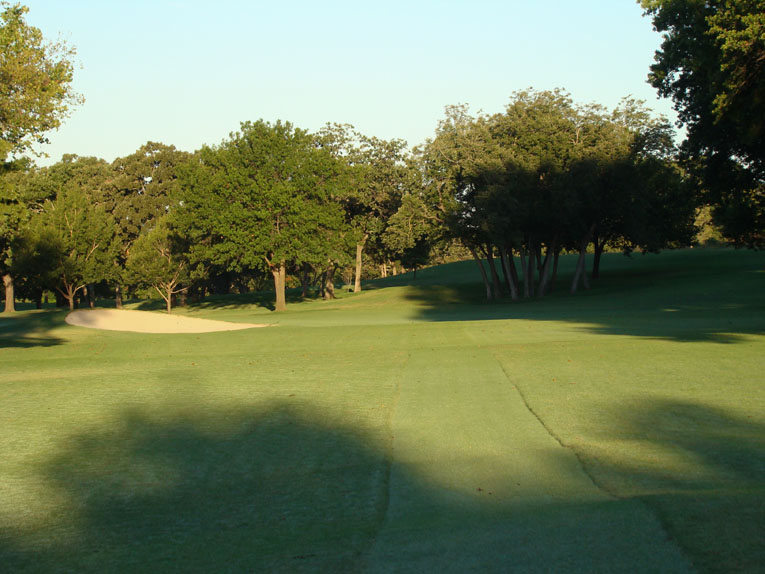
As seen in early morning light, the fairway bunker guards the inside of the dogleg as well as the most level area from which to play an approach. Shots played from twenty yards right have awkward stances with the ball above a right hander’s feet.

Maxwell worked on Augusta National Golf Club two years after building this hole. Comparisons with Alister MacKenzie’s half par thirteenth hole are inevitable.
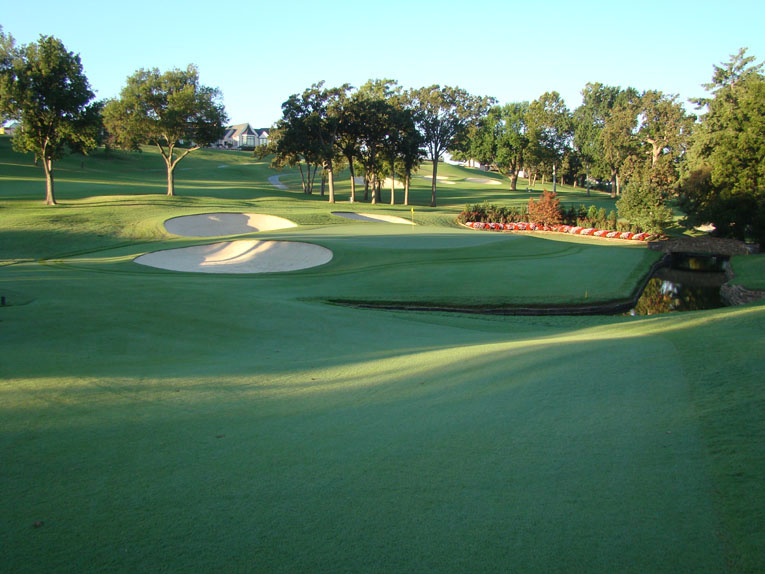
Maxwell’s use of the creek as a diagonal hazard is evidenced throughout the course and is exemplified here. The portion of the stream that trails down the fairway stops in the left edge of the photograph above. It is interesting to note that Maxwell piped twenty yards of it underground just prior to the green.

As seen from the back left, the sight of short grass feeding toward a hazard makes even the most hardened golfer flinch.
Thirteenth hole, 535/525 yards; In the author’s mind, the best way to follow-up a brutish half par hole is with, well, another half par hole. Both the twelfth and thirteenth are 4 ½ pars and how you elect to use your nine shots is up to you! Reaching this modest length par five in two is more complicated than one might initially assume. First, there is the matter of drawing a good stance in the fairway. Next, shots played from the left side of the fairway require the golfer to be mindful of an oak tree that hangs over the front left pond. In addition, the built-up green pad is only 25 yard deep, making it a tough target to hit and hold with anything other than a good strike. Ending up in any of the back bunkers at Southern Hills is a dire mistake that the golfer will soon regret.
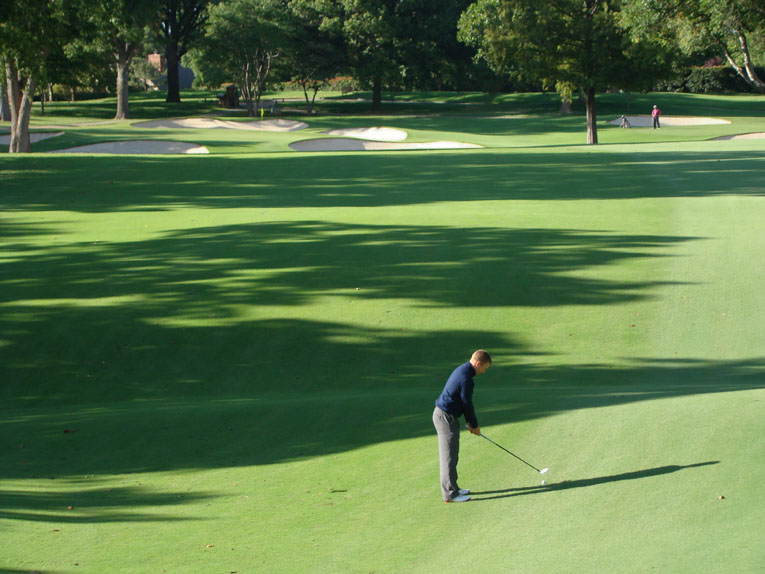
After a beautiful long drive into the middle of the thirteenth fairway, the golfer finds himself uncomfortably positioned with the ball six inches above his feet. Should he have a go at the distant green or should he lay up down the right center and stay short of the water hazards that guard the green? Decisions, decisions!
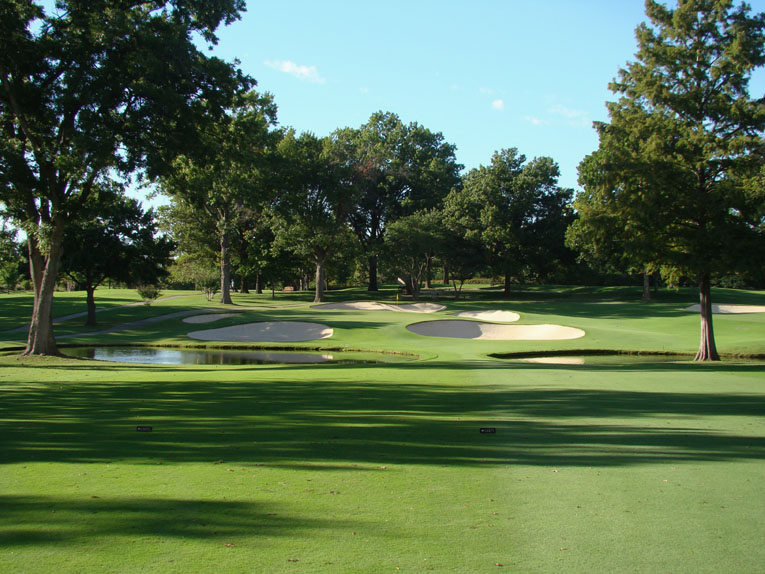
The oak tree just shy of the left pond has dropped many an ill-conceived shot unceremoniously into the water. Precision golf can yield the desired birdie but the hole possesses plenty of peril to snare indifferent tactics.
Fourteenth hole, 225/190 yards; Maxwell’s championship test manifests itself in several ways around the course. One is seen here with the number of bunkers. Generally, Maxwell’s work follows the ‘less is more’ design principle with one or two properly positioned bunkers providing more than enough playing interest. Here, he used six bunkers to virtually surround the target. The author is unfamiliar with any Maxwell one shotter that is more heavily bunkered.

Situated along a boundary road, the fourteenth playing corridor didn’t have natural features like so many others. Thus, Maxwell created man-made hazards (a.k.a. bunkers) to provide golfing interest of a similar high standard to the holes more naturally blessed.
Seventeenth hole, 360/335 yards; Nothing less than brilliant, this short hole has flummoxed golfers for generations. All the elements that make Southern Hills great are present: a convoluted fairway, a strategically placed stream, and a thought producing green complex, all played over lovingly cared for ground. And yet, a little known fact is unveiled in the Southern Hills club history book and that is that the left third of the green and its two bunkers were actually added in the early 1960s. Maxwell passed away in 1952 and the work was carried out by Loy Martin at the same time that he did the work at the seventh. In Maxwell’s day, the seventeenth green would have been tiny, well below 3,000 square feet. One can only imagine that finding four hole locations was taxing on such a small target and Martin’s work is to be applauded as both an artistic and strategic success.
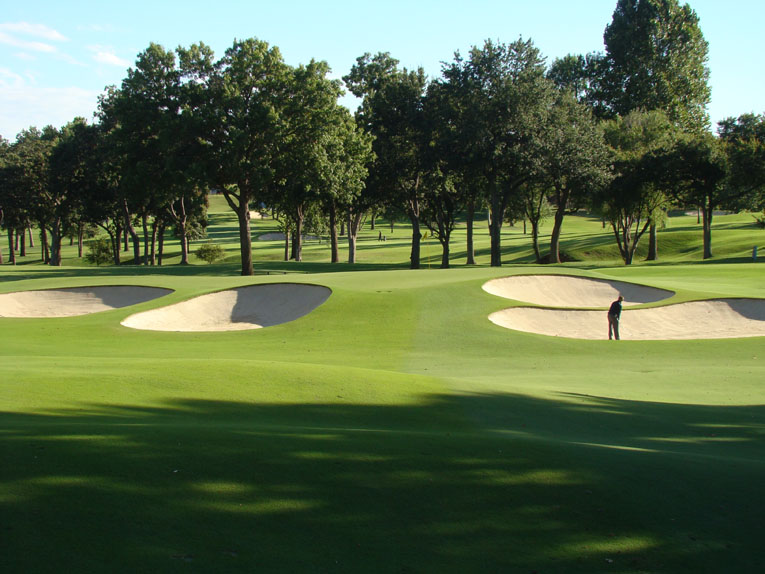
While still being unforced in appearance, the angled green has three distinct sections, all requiring a deft touch. A mere 22 yards deep, the green represents the most shallow target on the course. Note above the golfer and to his right how the short grass feeds off the seventeenth green and ties in seamlessly with the eighteenth tees. The introduction of short grass around these greens is an aspect that was missing in Maxwell’s day and adds a wonderful component.

Also, to repeat, the bunkers are deeper today than in Maxwell’s day. They act as true hazards and are one of the reasons that Southern Hills has withstood with grace the onslaught of advancements in the ball and clubs.
Eighteenth hole, 465/420 yards; Not all world class courses (e.g. Cypress Point, Royal County Down, Ballybunion, Fisher’s Island, Lahinch, etc.) enjoy a strong finisher. The one at Southern Hills feels like a truly epic Home hole. Pete Dye once remarked to the effect, ‘Show me an elevated clubhouse with pretty views and I’ll show you an uphill finishing hole’. That’s true here, and it’s infamously difficult, but there is much to admire. Frankly, the approach shot might be better today than in Maxwell’s day when it was excruciatingly long. At least with modern hybrids and metal woods, members have a decent prospect of landing on – and holding – the green. A successful approach here is one of those heroic shots that you remember after most courses have long faded from memory.

The drive is full of strategy. What to do? Play long left and stay on the high left side of the fairway? The approach will be longer but isn’t nearly as uphill. Play right into the inside of the dogleg just shy of the creek? Perhaps you will draw a level lie, perhaps not.
The last 160 yards scale steeply uphill to a green behind a massive front left bunker. The last shot of the day is every bit as daunting as the first tee ball is exhilarating.

Caught in the deepest greenside bunker on the course, aptly named ‘Jaws’, the golfer can’t see the top of the flag. Its dimension enhances the grand qualities of the Home hole.
After Southern Hills, Maxwell’s star shined brightly despite the wobbly economy. He went on to design Prairie Dunes in Kansas and work extensively at Augusta National Golf Club. Indeed, it seems accurate to state that around the world, MacKenzie and Maxwell of all architects performed the best work in the 1930s.
The members of Southern Hills are fortunate. The .65 mile drive up the winding entrance road sets the tone for a great day in a tranquil, gorgeous setting. Heading in, off to the right are nine holes built by Coore & Crenshaw in 1991. Stylistically, they blend well with the Maxwell holes and in no way compete. Highly underrated in the shadow of the main course, this nine would rank in the top handful of nine hole courses in the country, joining the Culver Academies, Sequatchie, Whitinsville, and Mike Kesier’s The Dunes. Don’t miss it if you have the opportunity.

As seen from the left forward tee, the eighth is a little beauty of a par three on the Coore & Crenshaw nine.
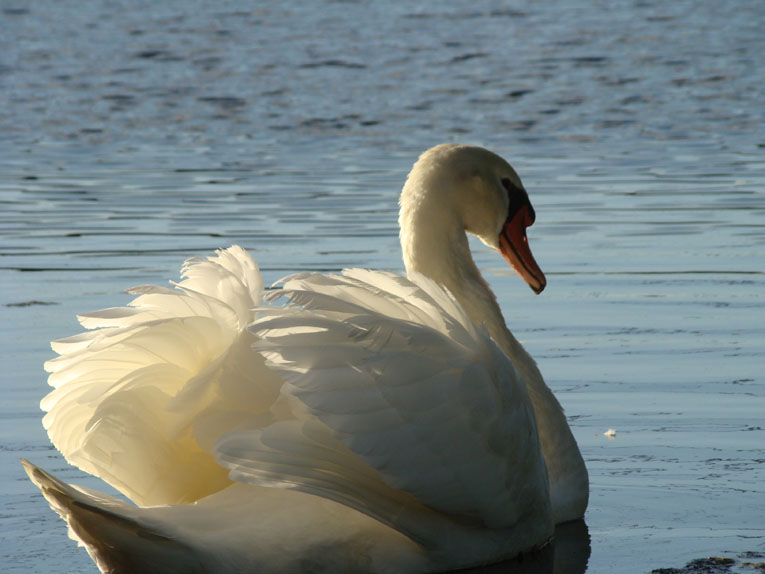
Duckie the Swan preens for the camera on the Coore & Crenshaw nine. It can’t be emphasized enough what a pleasant environment Southern Hills possesses.
Tiger Woods had a great analytical mind at the height of his powers in the mid-2000s. He used it to supreme advantage in winning the Open at Hoylake in 2006 and the PGA at Southern Hills in 2007. His play at both courses was tidy with his sparkling long irons from many tees continually putting himself in ideal positions to attack. As an interesting side note, the long-time Head Golf Professional Dave Bryan famously made two correct predictions. In 2001, he told a golf writer that Tiger didn’t have the patience to win the US Open at Southern Hills and in 2007, he told the same writer that Tiger now possessed the required demeanor to win the PGA Championship. Both statements proved prescient and highlight what a thinking man’s course Southern Hills is. Other skilled practitioners at managing their game like Raymond Floyd and Nick Price have – not surprisingly – won here.
There is no great architect that didn’t have a hand in courses that challenged the best golfers of his time. Southern Hills represents that for Maxwell, which would surely please the founders Messrs. Phillips, Warren and Canary. Their vision nearly eighty years ago has been far more than just realized. With Maxwell’s design as the backbone and its deep, gleaming bunkers and streams acting as a genuine hazards, Southern Hills is a standard-bearer of parkland golf. After 80 years it continues to tantalize the club player as well as the touring professional with a beguiling mix of brawn and finesse.
The End





